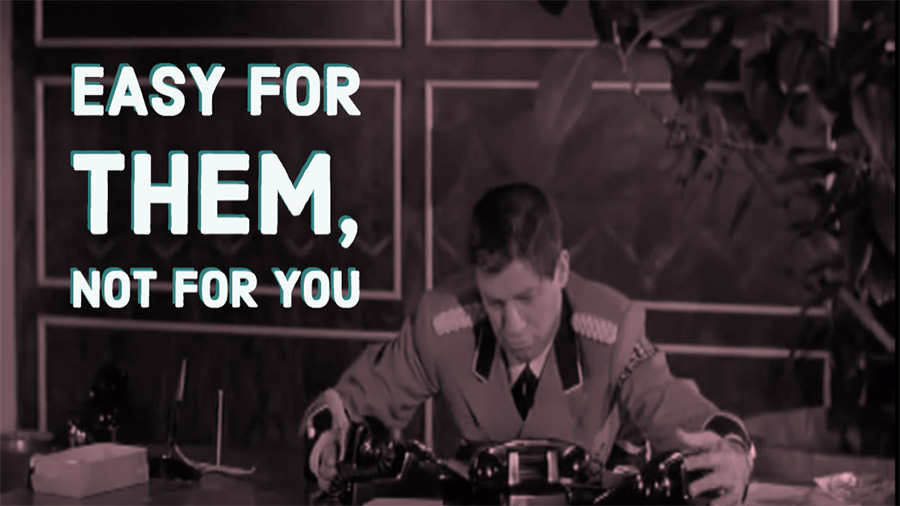Raise your hand if you LOVE to reach an automated attendant when contacting a company’s customer service number with a problem.
I don’t see very many hands raised, and most of them are standing in the back, close to the exits.
There are very few things more despised than navigating through a call-tree, yet they’re everywhere. It’s the world’s largest undocumented forest.
If customers hate them so much, why are there so many?
Because it makes it easier for the company.
Even premium companies who pride themselves on customer service make you fight your way through call-trees to speak with a human who can solve your problem. American Express has a 1-800 customer service number specifically reserved for platinum members only. When you call that number, do you know what you’ll hear? A pre-recorded voice:
“Please have your Platinum card ready. In a few words, please tell me how I can help you.”
You have to say “Customer Service” several times before the automated attendant quits asking you for more information, gives up, and connects you with a human being.
All of this because it makes it easier for American Express to deal with incoming calls from a group of people they’ve already identified as their most valuable customers.
Instead of aggravating your most valuable customers, there’s a better way that starts with asking a question. What makes it easy for customers? There are some customer service lines I call that answer on the first ring and an automated attendant immediately states my expected hold time, tells me I can press 1 for a call back from a customer service agent without losing my place in line, and adds that I may also continue to hold. Whichever is easier for me!
Go out of your way to make it easy for your customers, instead of easy for you. Every step of the way, as each customer interaction is designed, think about how to make it brain-dead easy for your customers even if it makes the process brain surgery difficult for the business.
There’s no better example of this than a doctor’s office and the initial paperwork they require their customers to fill out. (I intentionally used the word “customers,” but that’s a word you’ll never hear your doctor’s staff use. We are patients only, never customers in their eyes.) Can you imagine if you had to do this anywhere else you shopped? Imagine buying a new couch and before you’re allowed to talk to the salesman, a clerk stopped you.
“Whoa, whoa, whoa there, slick. Before you can ask anyone questions about couches, I need to know if you’re pregnant, how much alcohol you consume each week, and how your grandpa died.”
After a long time of searching, I finally found a dentist’s office I liked. I had tried them out on some minor dental procedures and felt comfortable with the staff and office. I was ready to commit to becoming a patient there.
When I went in to fill out the official new patient paperwork, I almost walked out and started my search all over again. The form was available exclusively on an iPad (no paper alternative for customers unfamiliar or uncomfortable with tablets). You could only select from pre-chosen answers in a drop-down box. If you left a question unanswered, the iPad loudly let you (and everyone else in the waiting room) know it. There were approximately 16 pages of questions and you had to digitally sign each page.
On a few of the questions my answer did not match one of the pre-chosen selections. “Pick the one that matches the closest,” was the instruction.
“What if there isn’t one that’s close? Can I just skip it?”
The iPad answered that question for me. “BRAP!” (Picture several teens in the waiting room looking at me like I might have wet leprosy.) I struggled through the rest of the questionnaire and sheepishly handed it in, like the last kid in the class to turn in his test.
The reason it was on the iPad with no option for a printed form: Easier for the staff to import into their patient tracking system.
The reason there were pre-selected answers with no room for variation: No messy typing or deciding for the staff. Easier to import into their patient tracking system.
The reason you couldn’t skip a question: Easier for the staff. They’d have to ask you about it and then enter it in themselves. Or just leave it blank and then have an empty cell in their system.
The end result for the staff: Easy, no mess, instantaneous data entry.
The end result for the customer: Frazzled, stressed out, and on edge BEFORE anyone jabbed something sharp in her mouth.
If you own a business with employees, you need to guard against this constantly. It’s not that your employees are evil or plotting against the company. It just happens, like water seeking its own level. In trying to make their job easier and more efficient, they make it increasingly more difficult for their customer, external or internal.
Back in the 90’s while working for another company, I watched a programming team struggle to develop an application for a team of buyers at the company. Knowing the buyers well, the programming team’s Project Manager emphasized the need to keep things simple. The team finished the application ahead of schedule, feeling confident they had achieved simplicity. It was anything but. The buyers refused to use the new system and kept going around it, using their old, manual methods.
After weeks of trying to sell the buyers on using the new system only to be rebuffed, the technical leader of the programming team, Joe, decided he’d had enough and gave everyone in the building a lesson on just how dead simple the new application was. He started explaining it on a white board. His Project Manager didn’t say a single word until Joe had finished diagraming the entire process on the white board and turned around in triumph; a smug look of satisfaction on his face.
“Joe, look up on the board and tell me how many steps it takes to buy one item.”
Joe made tick marks to the side of his elaborate diagram as he went through each step again. He turned around to speak, his shoulders slightly hunched, eyes downcast, and the smugness now gone, replaced with a slight grimace.
“47 steps.”
Silence crowded the room until Joe spoke again.
“We’ll start over from scratch right now.”
It took them longer to rebuild the application the second time around. And though it had been simple to code initially, it was anything but when they started over. But the final product they delivered took only 6 steps instead of 47 and was even simpler than the manual methods the buyers had been using. The application – rewritten with the purpose of making it easier for the buyers despite being harder for the programmers – was appreciated and embraced by the purchasing team.
Earlier this year, deciding the expense report process for our company was too cumbersome and time-intensive (mostly paper-based with manual entry), our accounting team worked on a revamp. I asked them to keep in mind one of our core values (“Remember who the customer is and act accordingly”) at the onset and further asked they consult with me when they were ready to start testing.
A few months later, the assistant controller came to me and announced they were ready. I looked over the instructions they planned to send to the test group and immediately had concerns. I asked how much longer they estimated it would take the field personnel to submit an expense report using this system than the way it had previously been done.
“Not long. Maybe about 20 minutes.”
The next question seemed obvious to me: “Then why are we doing this?”
“We have to manually enter all the expense reports now. This will save accounting about half a day of work every week.”
It was time to resort to math. “How many field personnel expense report do we usually process?”
She looked at some figures and replied that we averaged about 40 a week.
The accounting department, in order to save 4 hours a week, was prepared to ask their customers (the employees) to spend over three times that many hours a week to make it happen. And that ratio would only increase as the company continues to grow.
None of this is to say that she’s incompetent. On the contrary, she is an incredibly smart woman. But in this case, like all of us at times, she was looking at the trees instead of the forest. To her, the half-day it was going to save one person was highly visible and palpable. That person worked in the office right next to her. There was tangible work she could assign to her once the time was “saved.”
The day and a half it was going to cost the company (every single week, I might add), was invisible to her. To start with, every minute of that time was out in the field. Forty different individuals located anywhere from Mississippi to Arizona. On top of that, the aggregate time cost wasn’t as straight-forward as what she was witnessing first-hand in the office. Twenty minutes scattered across several states and God-only-knows who and when isn’t the same as Tammy’s time from 1-5pm every Monday afternoon.
The new expense report program is now on hold for all field personnel as accounting looks for ways to streamline it more.
Apparently, I’m on hold as well. With American Express still from when we started this story. I will try to hold my anger. It’s not going to be easy.
NOTES:
These are the companies that specialize in making it easy for themselves and hard for the customer.
TOP 10 WORST CUSTOMER SERVICE COMPANIES IN THE U.S. – 2018*
- CarMax
- Spirit Airlines
- Optimum
- Medicaid
- Comcast
- Hitachi
- Cox Communications
- Charter Spectrum
- Dollar Car Rental
- HSBC Bank
I think Comcast is a permanent fixture on this list; the only mystery left is where will they land between 1 and 10. I’m a little surprised that Sprint didn’t make the list. Maybe the T-Mobile merger has everyone distracted. Lastly, anyone besides me find it interesting that a company with “Communications” in its name would specialize in horrendous communication with their customers?
* Temkin Experience Rating from the Temkin Group.
The Weekly Struggle:
There are days when the writing comes easy. The words seem to flow like water through a fire hose, arriving quicker than I can type and capture them. Then there is every other day, where the words flow like blood from a rock. Every sentence takes its toll and a full page feels like I’ve been beaten with a butter sock.
Four out of five days this week were butter-sock days. Even though the writing pummeled the crap out of me this week, there was satisfaction that I struggled through it and still did the work. Surviving weeks like this helps me move from dilettante to professional. It’s a long journey.
New Book Spotlight:
Shane Snow’s new book Dream Teams, is a follow-up to his successful 2014 debut Smartcuts. Snow is a contributing science and business writer for both Wired and Fast Company magazines. The success of Smartcuts also launched Snow on the speaking circuit where he focuses on innovation.
In Dream Teams, Snow writes about collaboration and teams. Why do teams fall apart and fail to fulfill their promise in some cases, and only rarely achieve incredible success. What are the factors that differentiate the two and how can teams be aware of these pitfalls as they take step one?
Snow examines the FBI, the Wright Brothers, Daimler Chrysler, the Wu Tang Clan, and many other teams as he dissects successes, failures, and the potential implications of what he learned in the process.
Personally, I enjoyed Smartcuts and I purchased Dream Teams in late June, just a few weeks after it was released, but I confess that I haven’t read it yet. A few other books were already in line ahead of it, perched on my “on-deck shelf.”
Best Thing I Saw This Week:
On Friday, the Google Doodle of the Day celebrated Mr. Rogers with a stop-motion, animated video doodle set to the opening song of Mr. Rogers’ Neighborhood. Neither myself nor Mr. Rogers are Catholic, but that inconvenient fact does not interfere with my opinion that he should be sainted. If there was a person during my lifetime who was more of a Saint than Fred Rogers (who hasn’t already been sainted), then I don’t know who it could possibly be.
Earlier this year, the wonderful documentary Won’t You Be My Neighbor was released in select theaters* across the U.S. The film covered the life of Fred Rogers and his work of communicating to children with the warmth, sensitivity, and honesty that was his trademark. My bride and I went to see it at our local Alamo Drafthouse and there wasn’t a dry eye in the house. For the first time that either of us could remember, no one in the theater left their seat until the final credit had rolled.
* 893 to be exact; by contrast the latest film in The Predator franchise debuted on 4,037 screens
Best Thing I Heard All Week:
As I mentioned in last week’s Sunday Notes, our family went to see Austin Kleon speak at Texas Lutheran University in Seguin on Tuesday night. The talk was terrific, despite Kleon being affected by allergies. He structured his presentation very much like his books, including Keep Going, which won’t be out until April of 2019. In addition he gave some of the background on how he got started writing with his blackout poetry. Prior to his talk, I had been unaware of just how far his invention had spread in popular culture – being used recently by Roger Waters, U2, and even the front page of the New York Times.
Kleon will be speaking again in November in Pasadena, CA (Nov. 3rd) and Lake Charles, LA (Nov. 10th). It’s worth your time to attend if you’re anywhere close. Allergies be damned.
Quotes:
Make your product easier to buy than your competition, or you will find your customers buying from them, not you.
~ Mark Cuban
If you’re not serving the customer, your job is to be serving someone who is.
~ Jan Carlzon (CEO of SAS Group 1981 – 1994)
End Credits:
The picture from this week’s title card is from Jerry Lewis’s The Bellboy. Lewis and Jerry Seinfeld discuss the scene in the picture in the most recent season of Comedians in Cars Getting Coffee. The stock photos throughout the page all come from Pexels.com.
# # # # # #








0 Comments